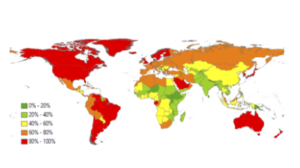Global famines strike as US budget shrink
 From the battlegrounds of South Sudan to the deserts of Yemen, a confluence of conflict and drought driven by climate change threatens to fuel a transcontinental famine, one that could easily escalate to the largest humanitarian crisis since World War II. The East African region faces its second severe drought in a decade, and it has arrived at the least fortunate time imaginable. Somalia remains lawless, South Sudan has devolved into chaos since its hopeful birth in 2011, and Yemen is a battlefield for the great powers and their proxies. In a region that has historically suffered from such food insecurity, these tragic circumstances risk the lives of tens of millions.
From the battlegrounds of South Sudan to the deserts of Yemen, a confluence of conflict and drought driven by climate change threatens to fuel a transcontinental famine, one that could easily escalate to the largest humanitarian crisis since World War II. The East African region faces its second severe drought in a decade, and it has arrived at the least fortunate time imaginable. Somalia remains lawless, South Sudan has devolved into chaos since its hopeful birth in 2011, and Yemen is a battlefield for the great powers and their proxies. In a region that has historically suffered from such food insecurity, these tragic circumstances risk the lives of tens of millions.
However, some of these conditions were certainly preventable. Experts say rising global temperatures have at least partially caused the rising frequency of droughts in the region, according to Voice of America. For example, an especially strong El Niño effect has exacerbated record-breaking temperatures, decimating crop yields across the continent.
In areas of the the region that may have otherwise endured the diminishing yields, the violence and instability of multiple civil wars has hampered local abilities to respond to the crises and brought millions to the brink of starvation, according to Al Jazeera. In a region that lacks both infrastructure and personal wealth, the havoc spread by these conflicts has proven nothing short of catastrophic.
Yet that those of us living in the global North are not helpless bystanders, condemned to watch our fellow humans starve to death - in the long run, the industrialized world can head off such disasters by limiting the carbon emissions that threaten to cause catastrophic warming in the Middle East. More immediately, the year’s coming famines could easily be mitigated. International aid organizations have learned valuable lessons from previous disasters, which should serve as models for the future: increased focus on water aid, hygiene, and—of course—more food would all help tremendously. Unfortunately, East Africans and Yemenis have suffered a final stroke of misfortune: their hour of greatest need comes just as the largest provider of international aid, the United States, turns its back on the humanitarian role it has played in the world for so long. The Trump administration has pressured Congress to make drastic cuts to international aid, particularly disaster relief, even as the greatest humanitarian crisis since World War II looms ever closer.
This is an especially shameless piece of political theater, considering that foreign aid currently makes up less than one percent of the United States’ yearly budget. However, in this time of dire need when the American contribution to foreign aid could be increased quite defensibly, Trump seems content to gut international aid to show his supporters how determined he is that their tax dollars will be spent on the unknown, the foreign, or the Other.
Will the wealthiest society in human history, a nation of Big Macs and diet pills, muster the political will to save a subcontinent from starvation? Or will we let our ideals die with our southern neighbors, in a craven bid to put “America First?” The world will be watching and history will be judging.
